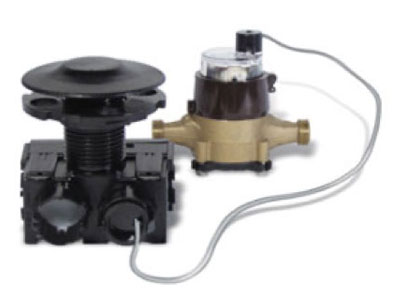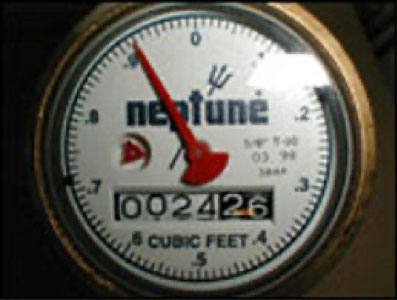If you have an AMI meter click this link to the Customer Service Portal (My Account) to see your usage analytics.
Otherwise information on your analog meter follows.

AMI Meter

Analog Meter
Understanding and Reading Your Analog Meter
There are two basic types of analog water meters – straight reading and circular reading.
The straight reading meter records cubic feet of water used in much the same way that a car’s odometer records miles. The dial with a single hand measures tenth of a cubic foot.
The circular reading meter uses a series of circular dials to record cubic feet of water used. To read this type of meter, start with the 100,000th circle, then read the 10,000 circle, and so forth on down to the circle that reads in 1 cubic foot increments. If a hand is between two numbers, always read the lower number.
This meter, for example, shows a reading of 2,425.92 cubic feet (the “6” in the last dial position has not quite rolled over). One cubic foot is 7.48 gallons of water. This meter has registered almost 18,146 gallons since it was new (2,425.92 x 7.48).
When the Water Authority reads your meter, only the white dials with the black letters are read to measure the number of “units” that have been used. One unit equals 100 cubic feet, or 748 gallons. In this example, the meter reading would be 24. This reading appears on the left side of your bill, in the box labeled “Metered Usage.” If the meter reading the month prior was 20, this customer would be billed for four units.
The triangle is a leak detector. The triangle will rotate if water is passing through the meter. If no one is using water, but the triangle is turning, you may have an undiscovered leak in your plumbing system.
For more information on your water usage: Understanding and Measuring Water Usage & Checking for Leaks
Understanding and Measuring Water Usage
To measure the amount of water used for any activity, follow these instructions:
1. Before you begin the measurement, write down the meter reading to two decimal places. (see the photo example above for help).
2. Perform the activity you want to measure, but be sure that no other water is being used during the test. Some examples include:
- Washing a load of laundry or dishes
- Taking a shower or bath
- Washing your car
- Watering your lawn
- Filling your swimming pool
3. If you are doing an activity that may have a variable duration, such as taking a shower or running your sprinklers, you should measure the number of minutes the activity required. This information will allow you to determine the number of gallons per minute the activity requires.
4. After the activity is complete, read the meter again. Subtract the first reading from the second reading, and then multiply the remainder by 7.48 to convert to gallons.
5. To get gallons per minute, divide the number of gallons by the number of minutes the activity required. For example, if you ran your sprinkler system for 10 minutes and used 110 gallons of water, your system uses 11 gallons per minute!
Keep in mind that the “units” shown on your water bill are equal to 100 cubic feet. The Water Authority water meter readers only record complete units for billing purposes, so the last two digits (the “tens” and the “ones” figures) are omitted. Remember: one unit equals 748 gallons, so one cubic foot equals about 7.5 gallons.
Using your Meter to Check for Leaks
If you suspect you have a leak, you can measure the volume:
- Write down the meter reading and the time of day to the minute.
- Don’t use any water during the test. Usually it is best to do this when you will be away from home for an hour or more. Make sure devices such as evaporative coolers and ice makers are turned off.
- Read the meter again when you return and note the time of day.
- Subtract the second reading from the first. Multiply the remainder by 7.48. This is the number of gallons that passed through the meter during the test period.
- Divide the amount of water by the number of minutes in the test. For example, if 17 gallons leaked out during a 180 minute period, you have a leak of 0.094 gallons per minute.
- Multiply the gallons per minute by 1,440 to calculate gallons per day. Multiply gallons per minute by 43,920 to calculate gallons per month. In this example, just 0.094 gallons per minute equates to over 4,128 gallons each month!

